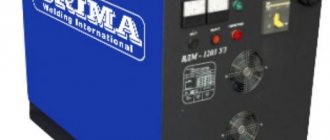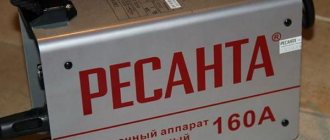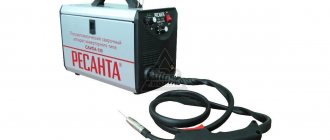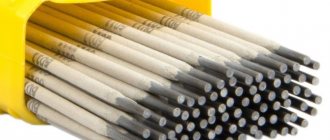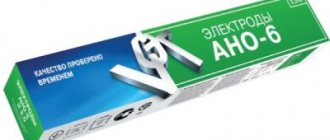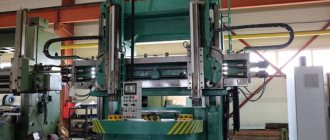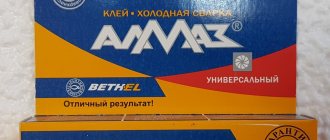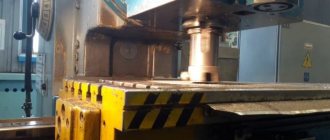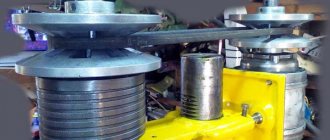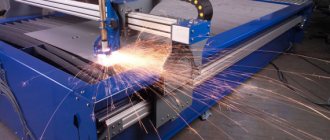Home / Devices
Back
Reading time: 1 minute
0
768
Among many old school welders, you can often hear about VDU 506 and VD installations. These welding rectifiers have a proven track record of safety, strength, and simplicity.
The quality of these devices has been repeatedly confirmed by the best people in their industry. They can be repaired without any help. And if the need arises, you can contact the service, it won’t cost much.
The widespread use of miniature models has not in any way affected the use of large, but nonetheless powerful welding machines.
Old welders are known not only among craftsmen, but also among beginners who want to purchase a quality product at a low price. This time we want to talk about such a rectifier as the VDU model 506, in the 506C UZ variation.
- Device information and properties
- Peculiarities
- FINAL PART
General information and characteristics
The welding machine model VDU-506S U3 is a mobile welding rectifier designed for manual arc welding using a coated electrode. The device operates on direct current, the body is made of durable metal, and there is a forced cooling system. This model produces up to 500 Amperes and requires 380 Volts for power.
Please note that VDU 506 is a single-station device. If you need to organize several jobs at once, then it is better to purchase a multi-station welding rectifier.
Also, in addition to manual arc welding, you can cut and surfacing metals using the same coated electrodes. Additionally, you can connect a feed mechanism and a torch to the machine to use it in MIG/MAG mode. Please note that for MIG/MAG welding, the VDU 506 you choose must include a feed mechanism. You must purchase the burner yourself.
Appendix 3
Cleaning welds from slag should be done only after the seam has completely cooled, and always while wearing glasses with plain lenses. The windings are made of aluminum winding wire of the APSD brand.
The external characteristics are shown in Figures 5, 6 and 7. In manual arc welding mode, the voltage at the working clamps is 40 V. A stable arc, high-quality seam and reliable design make this device an ideal machine for any enterprise.
The current adjustment range depends on external characteristics.
A rectifier control unit is installed in the upper right part of the front wall. Claims about inconsistency of the used configuration with the diagrams and lists of the passport by the manufacturer will not be accepted. Precious materials specified in GOST 2.
Read more: Estimate for installation of electrical equipment sample
The electrical circuit diagram is shown in Fig. When operating the rectifier on a PC, the mode is selected by test welding. When welding on a PC with straight polarity, connect the cable connected to the electrode to the “—” connector. All repair and maintenance work should only be carried out after disconnecting from the mains.
Ground one of the output terminals of the rectifier depending on the welding polarity. To do this, you need to: - make a bracket according to the drawing given in Appendix 5; — make 3 pieces of cable with a cross-section of at least 10 mm2; — dismantle the cover covering the window for installing the circuit breaker; — install the switch in the window and secure it with a bracket; — connect the cables to contacts 1, 3 and 5 of the starter pos. In manual arc welding mode, the voltage at the work clamps is 40 V. Operation without a protective casing is prohibited. The appearance of the external characteristics is shown in Figures 5,6 and 7.
File information
If ventilation is disrupted, the KM2 starter, in the circuit of which there are KVZ relay contacts, disconnects transformer T1 from the network. To do this, you need to: - make a bracket according to the drawing given in Appendix 5; — make 3 pieces of cable with a cross-section of at least 10 mm2; — dismantle the cover covering the window for installing the circuit breaker; — install the switch in the window and secure it with a bracket; — connect the cables to contacts 1, 3 and 5 of the starter pos. The electrical circuit diagram is as follows: By its design, the VDU welding machine is a step-down transformer with a semiconductor block that rectifies the incoming current. When servicing and operating the rectifier, it is necessary to comply with the requirements of regulatory documents on occupational safety in force in the region where welding work is performed.
Each rectifier is designed for only one of those indicated in the table. Precious materials specified in GOST 2. The power rectifier unit consists of six thyristors VS1-VS6 7 type T-T, assembled according to a six-phase rectification circuit with an equalizing reactor. When the rectifier is properly cooled, air should be drawn in from the valve side. VDU 506 in real factory conditions - repair (spontaneous shutdown).
Peculiarities
There is a myth that a welding rectifier cannot be used indoors. But this does not apply to the VDU 506 model. It feels great in the presence of natural ventilation (cracks, open windows, etc.). And even more: this device is capable of operating at very low temperatures down to -40 degrees.
However, this rectifier is not intended for welding in explosive atmospheres. The released vapors and gases can damage the welding machine or completely destroy it.
We are accustomed to thinking that a transformer and rectifier are difficult-to-use devices. This is largely true. But the VDU 506 model does not have many disadvantages. The arc ignites easily and burns stably, provided that you have provided sufficient voltage in the network to power the device. All this is possible thanks to improved characteristics. We can say that VDU 506 is a significantly modified version of the classic rectifier.
Types of rectifiers
There are several types of rectifiers:
- welding thyristor rectifier VD 313 SE, VD 306;
- inverter power rectifier (welding);
- throttle;
- transistor (station wagon).
What is the difference between these devices?
Thyristor power supplies are suitable for various types of arc welding electrodes and can be used for welding work on rods.
Advantages:
- Higher efficiency compared to conventional rectifiers.
- Excellent arc characteristics, much smaller spark.
- Single row current control
- Easy to implement remote control function
- Good strength against voltage fluctuations
- Suitable for outdoor use.
- This is a multi-station welding rectifier - vdm - 1201, 2x313, vdm-1202 s, 1001, selma, BC ma, 6303 s.
The throttle rectifier is designed for welding in the most severe operating conditions (quarries, mines, pipelines, etc.). It provides semi-automatic welding and surfacing for currents up to 650A. In semi-automatic welding, the operating voltage is adjusted in steps. The single-station welding rectifier is represented by VDU 505, 504, VDU 506, DUGA professional and DUGA industrial.
Circuit: Throttle rectifier
In addition to the main choke, the welding arc power supply system has another one built into the parametric section, which can significantly improve the quality of the weld due to the stabilization of welding. As a rule, in addition to the main power winding, an auxiliary winding is also used, which serves to regulate the inductance of the inductor and, thereby, controls the peak point during a short circuit or voltage surges.
The inverter rectifier is used to convert incoming alternating current into direct current, represented by models esab, man,. This current switches on and off very quickly, creating a pulsed, high-frequency DC current. Typical frequencies range from 10,000 to 20,000 Hz, but data up to 100,000 Hz is possible. The inverter, like the entire welding rectifier, needs to be checked every six months. The welding inverter rectifier is represented by the models electron 125, sun 600, 318m1, arc, neon (naks), afterburner, power, paton, terminator and anode (USSR).
Video of economical operation of a welding rectifier
Transistorized welding power sources have been developed for precise control of welding parameters. The speed of operation and response of transistors is very fast, hence such power sources can be adjusted to give any desired I-V reading between direct current and constant type voltage. In addition, the control system can be programmed to set the variable current and voltage during the actual welding operation. These technical features make the universal transistor welding rectifier particularly attractive for welding pipes, ventilation passages and shafts. Welding can be carried out using free-standing electrodes.
Almost every master has gasoline welding rectifiers (Esva, Loris). These are quite convenient portable devices, with which it is convenient to carry out work on the road or in the open air. There are very good reviews about the fubag welding rectifier, and its characteristics indicate that the device is also suitable for use in a local power supply network. In addition, these devices are often equipped with a portable charger.
If we distribute rectifiers by area of application, we get the following table:
| Application area | Rectifier name |
| For surfacing metal under a flux layer | vdu |
| For simultaneous power supply of several welding stations | VKSM |
| Used to power the welding machine when working with structural and alloy steels. Widely used in public utilities, everyday life, small workshops and workshops. | VDMSH |
| In cold car engines, an arc frequency universal device is often used. | VDUCH and VDC |
Safety precautions when using this device
Safety requirements do not differ from standard rules for the operation of electrical installations:
- It is not allowed to allow persons who do not have the appropriate permit to work with the rectifier.
- Operation without grounding is prohibited. Occupational safety regulations require that a sign “Do not turn on without grounding” be placed on the housing. It is not permitted to use another welding machine for grounding. This work must be carried out by a qualified electrician.
- Operation without a protective casing is prohibited.
- Before moving the device on the job site, it must be de-energized.
- Before dismantling the side parts of the casing, it is necessary to disconnect the device from the power supply.
- It is prohibited to operate the device if the conductive insulation is damaged.
- When working with a rectifier, it is necessary to use personal protective equipment - a mask, leggings, and overalls.
- It is prohibited to touch live elements.
- It is forbidden to look at the electric arc without protecting your eyes with a mask with light filters.
- Finishing work on mechanical cleaning of the welding seam must be carried out wearing protective glasses to avoid the ingress of slag fragments.
How to make a straightener?
If you have minimal technical knowledge, making a welding rectifier with your own hands is not difficult. We first select a ready-made transformer with a step-down effect of the required range. Most often this is very difficult to do, and you have to wind it yourself. Detailed instructions for assembling the rectifier.
Welding rectifier circuit
We propose to make the simplest homemade welding diode rectifier. It must be assembled using a bridge circuit and mounted on a radiator so that the device is cooled all the time. The fact is that powerful diode lamps (VD type). To ensure a falling or hard characteristic, it is necessary to include a special inductor in the circuit. Next, a rheostat is attached to ensure smooth adjustment of the operation of the rectifier.
The electrical circuit of the rheostat is quite simple, you can wind it around the core with your own hands, you only need a simple copper or aluminum wire. But before work, you need to calculate the required resistance: the voltage adjustment depends on the diameters of the turns.
To make the task easier, you will definitely need not only a detailed instruction manual, but also a circuit diagram.
Symbol structure
Let's decipher the name using the example of a welding rectifier VDU-506S UZ1:
- B – rectifier.
- D – arc,
- U - universal,
- 5 – welding current strength, which is indicated in hundreds of amperes,
- 06 – serial number of the model,
- C – manufacturer’s marking. In this case, the rectifier was produced by an electrical engineering company located in Crimea.
- UZ1 is the nature of the execution and the category of placement of the model.
Operating conditions are subject to the requirements of Interstate Standards.
Frequent breakdowns and how to fix them
During operation, the user may encounter the following problems:
- The device is constantly disconnected from the power supply . There may be several reasons: a short circuit at the rectifier terminals, breakdown of thyristors, or a short circuit to the housing of the secondary winding of the transformer. An ohmmeter should be used to localize the breakdown. After this, eliminate the problem.
- There is no voltage at the output . As in the previous case, there may be several reasons: failure of the voltage regulator, failure of the fan, failure of the wind relay, open circuit or failure of thyristors.
- Operation on harsh external characteristics is not possible . In this case, you should check the feedback circuit for voltage - there is a break somewhere.
- Unstable operation on falling and hard external characteristics . Most likely, the control signals do not reach some thyristors. First of all, you should check for the presence of signals. In case of absence, it is necessary to sequence their formation and find the cause of the break. To do this, you should use an oscilloscope. The average pulse value is 1.5-2 V.
- Unstable operation at hard specifications . This picture is observed when the circuit of the auxiliary winding of the inductor is broken.
If you have professional skills, you can easily repair this device.
[/stextbox id='alert']Important. All repair and maintenance work should be carried out only after disconnecting from the network.[/stextbox]
Design and principle of operation
The general view of the rectifier and its overall dimensions are shown in the figure.
Designations
- “1” – overload sensor indicator,
- “2” – network power indicator,
- “3” – socket for heating connection, when working with protective gas,
- “4” – socket for connecting the control unit of the semi-automatic device,
- “5” – place for installing the control unit of the semi-automatic device,
- “6” – Control unit of the device,
- “7” – remote control on/off button,
- “8” – current indicator,
- “9” – voltage indicator,
- “10” – selection of external characteristics “hard/falling”,
- “11” – welding mode switch,
- “12” – regulator of output parameters,
- “13” – button to turn on the cooling system fan,
- “14” – button to turn off the cooling system fan,
- “15” – connection point for welding cables,
- “16” – connection point for grounding cables,
- “17” – circuit breaker toggle switch,
- “18” – area for connecting network cables,
- “19” – handle for moving on the production site.
The electrical circuit diagram looks like this:
By its design, the VDU 506 welding machine is a step-down transformer with a semiconductor block that rectifies the incoming current . During operation, the diodes of the unit are subjected to heavy load, which causes an increase in temperature.
To remove heat, the devices have a cooling system, which consists of radiators and a fan. The rectifier benefits from smooth adjustment of the welding current. If necessary, it is possible to supply a special remote control for remote adjustment of the welding process.
The factory set of supplied equipment includes:
- Straightener with handle and wheels for transportation.
- Set of current inserts.
- Passport with instructions from the manufacturer.
How to choose a straightener?
It is very important to pay attention to the manufacturer and product description. Before you buy a welding rectifier, you need to check its passport, certificate, type (indicated on the back panel, silver metal sheet), and the price is especially important.
On average, the cost of this electrical device ranges from $1,000 to several tens, depending on the rated voltage and purpose. But in most cases, free delivery and installation of the unit are provided.
The most popular companies now that produce welding rectifiers are: Origo, Blueweld, Brima, Tig, Caddy, Lhf, Pico, Lincoln (made in the USA), Foxweld, Zx, Mig, Kind, Linkor, Weld, Aristo, Prestige, Invertec.
You can buy a cheap welding rectifier from manufacturing plants both in Russia and Ukraine - Moscow, Chelyabinsk, Ufa, Samara.
